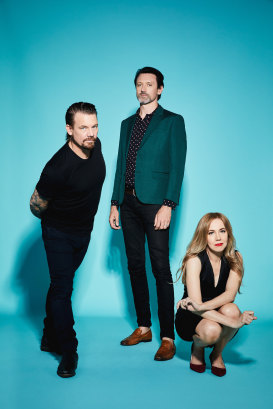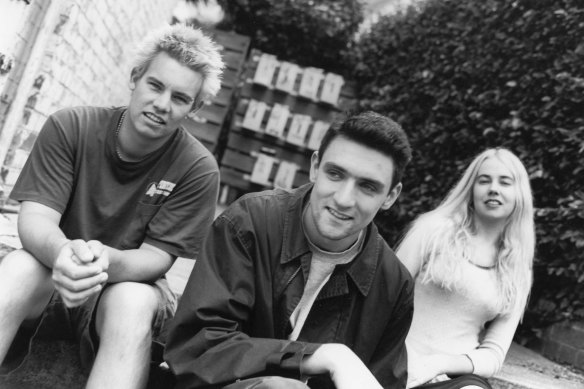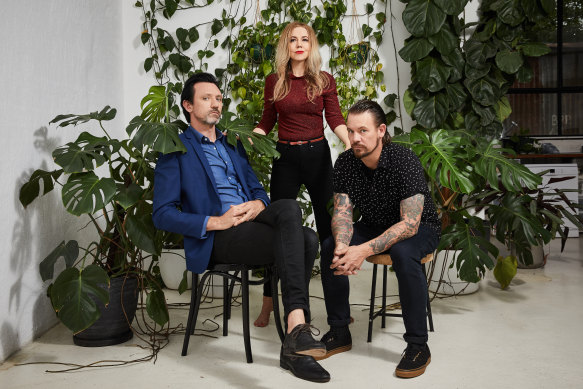This was published 4 years ago
Did Something for Kate see it coming? Album taps funny side of doom
The drawings on the kitchen bench are mostly empty American streetscapes. Geometric freeways, vintage diners and desolate doughnut stands are eerily suspended in scribbled coloured pencil. "As you can see, we’ve been busying ourselves in lots of new creative ways," Paul Dempsey says as he flips through one of his strikingly neat lockdown sketchbooks.

Something For Kate, from left, Clint Hyndman, Paul Dempsey and Stephanie Ashworth, are releasing their first album in eight years.Credit: Daniel Boud
Stephanie Ashworth, his wife and bassist in Melbourne rock trio Something for Kate, leans on the other side of the kitchen island. In a long, high alcove behind her spans a giant model of the Golden Gate Bridge, a cheap plastic Statue of Liberty and other kitsch delights.
"We spend a lot of time in America," she says. "We were there three times last year. We were there at the beginning of lockdown, in Los Angeles. It’s pretty tense." US-based members of her family are running the gauntlet between COVID-19 in Florida and wildfires in San Jose. Their friends are all "hightailing it out of there", Dempsey reports. "The violent chapter," he predicts drily.
The couple’s five-year-old daughter, Lake, totters in to whisper something about her imaginary friend, and to eye the stranger cautiously. We stop talking and smile.
In normal times, this house would be buzzing with imminent departures. Fans are counting the days until Something for Kate’s first album in eight years, The Modern Medieval, but with little hope of the communal gatherings such an event traditionally entails. Instead of tour T-shirts, Ashworth has designed a brilliant merch item: Something For Kate performing in their own snowdome. Going nowhere.
"Everybody talks about the middle ages as if it was actually in the middle ages," Bob Dylan wrote in his 1966 novel, Tarantula. Who knows exactly what he meant, but the idea of humanity in stasis, or dark times returning, or that linear history and progress are illusory, strikes a chord with the Modern Medieval theme.

Something for Kate in March 1998. Credit: Andy Mac
"There’s this idea, I guess; you grow up feeling like things can only ever get better," Dempsey says when the grown-ups are alone again. "But that isn’t the clear path of history. You read about medieval times or the Dark Ages or whatever you want to call it and there’s absolutely no reason that things can’t get that bad again. Serfdoms and fiefdoms and tribalism and power being in the hands of a small few. It’s kind of where we’re at again."
It’s the way he tells ’em, folks. The bleakness of Dempsey’s world view is something of a cliche in Australian rock. The riposte is that no, actually, he’s just got a priceless sense of humour. Both are true. "He shoots a pretty straight bat, in the media and on stage," says drummer Clint Hyndman, his Mornington school friend turned bandmate of 26 years. ''You know, he’s a six-foot-seven guy with a furrowed brow, so people take him [at face value]. He’s actually one of the funniest guys I know."
Another classic merch item on the kitchen shelf puts the in-joke in perspective: the Paul Dempsey bobblehead was a hit with fans around the time of his last solo album, 2016's Strange Loop. The pitch on the box says, "Tap the giant noggin and watch that troubled head dance!!"
"If I had to sum up my most frequent subject matter, my ‘well’, if you like, it’s human fallibility," he says. "It’s endless. And it can be funny and sad; political, social, romantic or whatever and just interesting in so many different ways. It can give you funny songs or whimsical songs or — or deeply depressing songs," he allows with a laugh.
Light and dark
The balance of light and dark is finer than ever on the trio’s seventh album. Dempsey reckons he left the "overtly political" behind with The Official Fiction in 2003, a record mired in the cynicism of the Bush/Iraq era. "These [new] songs are small, individual universe kind of stories," he says.
The way they come across — less dense, more head-bobbling if you will — is partly down to Ashworth’s determined influence. "We’ve spent our career resisting the easy hook," she says, as he stifles an objection. Her husband’s prodigious musicality — perfect pitch, annoying fluency on everybody else’s instruments — has been known to amount to a certain degree of complexity. "And I kind of knew that [musician, mixer and producer] Howie Beck, from his own records and projects that I’ve heard, that he had a bit of a pop [preference]," Ashworth says. "And that he and I could conspire against Paul."
Beck’s mix, in Toronto, was the final step in the band’s typically methodical and entirely self-determined album construction plan. First, as always, came the meticulously detailed demos, layered in the spare bedroom upstairs. Fans have since become well acquainted with the white-walled, instrument-lined attic space during lockdown, as the pair performed an evolving stream-fest of covers, rarities and long-range duets.
Thematic references to the end of the world as we know it were entirely coincidental.
Next, they took the family — Miller, 9, is in school today — to enjoy the spectacular ocean panoramas of La Cueva Studios outside Byron Bay, co-owned by Bernard Fanning (he duets with Dempsey on one song, Situation Room) and American expat producer Nick DiDia, whose work includes Powderfinger, Pearl Jam and Bruce Springsteen.
This was all pre-COVID-19, of course. So any thematic references to the end of the world as we know it were entirely coincidental.
"Paul wanted to call the album The Garden of Frozen Billionaires," Ashworth reveals. It’s a line from the song The Last Resort, which describes a surreal future meeting in Queenstown, New Zealand, aka "the Armageddon bunker", where Silicon Valley escapees are reportedly buying up property in preparation for the imminent apocalypse.
"They had to change the foreign ownership laws and visa controls in New Zealand because all these billionaires were buying up all the land because the bedrock around there is so solid, and the access to clean water is great," Dempsey explains. "You know, it’s a ski resort town. But the way things were going, a lot of people thought it was going to be the last resort town."
Says Ashworth: "I think you were reading Don DeLillo. So yeah, this idea was quite a central focus for Paul. But I said, ‘You have to resist calling it that because it reduces an album that has so many different ideas to being about one thing’. It’s too brutal."
Sculpture garden of Eden
Dempsey smirks. "The garden represents Eden but you know, it’s like you’ve stumbled into this new beginning, but there’s all these frozen billionaires everywhere. And then you’re faced with the decision of, do I thaw them out and tell them what happened? Or do I just make a sculpture garden and turn them into art pieces as a symbol of what went wrong? To me, that’s hilariously funny. But we’ll see."
The survivors of the last resort are just two of the lost souls seeking connection who make the album’s heart beat. "Richard don’t make me come looking for you in Los Angeles," goes the opening of the first track, All The Great Minds. It seems to be about one friend trying to save the other from Hollywood delusions that turn deadly in the last verse. Metaphor or what?
Blue Bird, which Dempsey will shortly retire upstairs to perform solo and exclusively for readers of The Age andSydney Morning Herald (video below), is another intimate conversation between survivors. "It’s sort of a country song," Dempsey says. "And it’s probably the most traditional kind of love song on the record, but I guess it’s two people ducking into a bar to escape from something.
"Blue Bird references, I guess, just the noise of society. Things being overrated or things being underrated and just that constant talk about dead celebrities and who’s wearing what." Here and throughout the album, "there is a bit of a sense of different people wandering in a post-something landscape. But what that something is isn’t really stated".
'Everything’s on fire. But there’s a bar here where you can go forget about it all.'
Stephanie Ashworth, Something for Kate
Says Ashworth: "Everything’s on fire. But there’s a bar here where you can go forget about it all." We laugh because it’s true. At a time when their Melbourne neighbours are rushing back to sanitised bar stools after months in their respective bunkers, it all feels weirdly prescient.
One of those bars — and another one back in Mornington — are suddenly keeping Clint Hyndman incredibly busy. He started his hospitality empire 14 years ago, around the time Dempsey began work on his first solo album, Everything Is True. At that time, some assumed Something for Kate had reached the inevitable exhaustion that’s befallen most of their peers from the Big Day Out generation. Six years after their 20th anniversary tour, their ongoing livelihood is a rare distinction.
"Paul and Steph have been together since the band started," Hyndman says. "I think it’s become a bit more important to mention that if you’re talking about how we’ve been together so long, it’s because of how they work together as a couple.

"Hopefully we might at least be able to get together in a rehearsal room in a few weeks’ time,'' says Paul Dempsey, left. He and Stephanie Ashworth have been releasing YouTube videos during lockdown, while drummer Clint Hyndman has been apart on the Mornington Peninsula. Credit: Daniel Boud
"They can be quite fiery with each other in the writing and I’ve been that mediator in the middle … but the only time it’s actually been an issue for me is in this last year of being locked down. Obviously, you’ve seen the YouTube videos of the two of them playing and doing all that stuff?" Yeah, that’s got to hurt.
"Hopefully," Dempsey says, "we might at least be able to get together in a rehearsal room in a few weeks’ time," even if nobody can quite say what the rehearsals are for. Ironically, it’s the bands with the largest followings that will come last to whatever the post-something live performance scene looks like.
"You hear all these ideas about venue numbers; they’ll be able to open and have 50 people," Ashworth says, shaking her head. "We can’t do any of that. We were going to do a national tour and it’s theatres, you know, Forums and Enmores and it’s exactly those venues that are going to have trouble being viable. So we’re just waiting, really."
In that, they’re not alone. Best grab a Something for Kate snowdome while stocks last.
The Modern Medieval is out November 20.